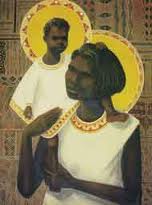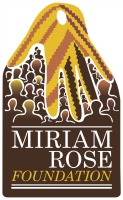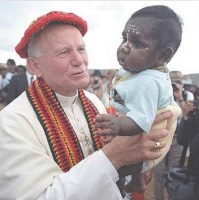Launch of the Miriam Rose Foundation, St Mary's Cathedral Darwin, 22 October 2013
 I join with you all in acknowledging the Larrakia people as the traditional owners of the land on which we meet. Thank you, Bishop Eugene Hurley for your gracious welcome and for making this splendid cathedral available for today's launch of the Miriam Rose Foundation. We all take to heart Bishop Eugene's observation that this Cathedral is a cathedral for everyone, and not just Catholics and not just residents of Darwin. It is one of the great meeting places of the Top End. I am honoured and humbled as a whitefella from the south to be Patron of the Foundation dedicated to furthering the work and vision of Miriam Rose Ungunmerr. Celebrating mass here this morning, I recalled that I first came into this Cathedral in 1981 with Bishop John O'Loughlin MSC. He rounded out the tour of the cathedral by taking me down to the crypt and showing me where he was to be buried. And that's where he lies today. At that time there was no significant Aboriginal art work here in the Cathedral. But in pride of place was Czech artist's Karel Kupka's Aboriginal Madonna and Child. Jolly O'Loughlin had taught my father at school. He had also taught Brian Sweeney a man familiar with the arts. One evening, the bishop had visited Sweeney's home in Brisbane and admired the portraits that Sweeney had commissioned of his children. The bishop told Sweeney how good it would be to have a fine portrait of an Aboriginal Madonna in the new cathedral he was planning for Darwin. Returning to the north on the lookout for an artist, O'Loughlin then met the travelling Karel Kupka on the Tiwi Islands. On learning that Kupka was a Catholic, he commissioned him to do the work. Today that iconic painting is complemented by the stained glassed windows replicating the artwork of Aboriginal artists — Larrakia being joined by artists from Nguiu, Palarumpi, Nauiyu, and Santa Teresa. The art which now surrounds us in this Cathedral tells the story of Aboriginal participation and self-determination.
I join with you all in acknowledging the Larrakia people as the traditional owners of the land on which we meet. Thank you, Bishop Eugene Hurley for your gracious welcome and for making this splendid cathedral available for today's launch of the Miriam Rose Foundation. We all take to heart Bishop Eugene's observation that this Cathedral is a cathedral for everyone, and not just Catholics and not just residents of Darwin. It is one of the great meeting places of the Top End. I am honoured and humbled as a whitefella from the south to be Patron of the Foundation dedicated to furthering the work and vision of Miriam Rose Ungunmerr. Celebrating mass here this morning, I recalled that I first came into this Cathedral in 1981 with Bishop John O'Loughlin MSC. He rounded out the tour of the cathedral by taking me down to the crypt and showing me where he was to be buried. And that's where he lies today. At that time there was no significant Aboriginal art work here in the Cathedral. But in pride of place was Czech artist's Karel Kupka's Aboriginal Madonna and Child. Jolly O'Loughlin had taught my father at school. He had also taught Brian Sweeney a man familiar with the arts. One evening, the bishop had visited Sweeney's home in Brisbane and admired the portraits that Sweeney had commissioned of his children. The bishop told Sweeney how good it would be to have a fine portrait of an Aboriginal Madonna in the new cathedral he was planning for Darwin. Returning to the north on the lookout for an artist, O'Loughlin then met the travelling Karel Kupka on the Tiwi Islands. On learning that Kupka was a Catholic, he commissioned him to do the work. Today that iconic painting is complemented by the stained glassed windows replicating the artwork of Aboriginal artists — Larrakia being joined by artists from Nguiu, Palarumpi, Nauiyu, and Santa Teresa. The art which now surrounds us in this Cathedral tells the story of Aboriginal participation and self-determination.
After my tour of the Cathedral in 1981, I then accompanied a carload of MSCs down to Daly River where the Jesuits had first established a mission 99 years previously. That was the first of many visits over these last 32 years. Each time I went I admired Miriam's stations of the cross in the Church of St Francis Xavier and I was captivated by the pulpit painting she did. With her permission, I photographed it and my mother then made a splendid tapestry of the pulpit painting which is the centrepiece of my 1985 ordination vestment. I still wear that vestment for special occasions such as the annual NAIDOC Mass and family celebrations. Other priests and bishops have worn it for major Aboriginal liturgical celebrations. For three decades I have admired Miriam as an artist, an educator, a community leader, a spiritual contemplative and as a friend.
One of the advantages of flying Jetstar through the night from Sydney is that you have little to do but think and pray. Last night, contemplating Miriam Rose's vision and all that her community has endured and celebrated these last 32 years, I was consoled at the thought that her vision in the midst of turbulence, dadirri in the midst of noise and turmoil, has always been CLEAR:

C: culture and Church
L: local leadership and expertise
E: education
A: art
R: reconciliation, recognition and respect
A short word about each.
Culture and Church: I recall the baptismal celebration of the feast of the Epiphany in 1987 down at Nauiyu Nambiyu. We spent about a week planning the baptism of 12 kids using traditional symbols including the water ceremony to welcome newcomers to country, the firesticks, the smoking, and the ti tree bark to heal and make strong. Miriam has always drawn strength from culture and church no matter what the internal tensions.
Local leadership and expertise: There are many Aboriginal foundations the length and breadth of Australia now. What's distinctive about the Miriam Rose Foundation is that it is primarily focussed on the community of Nauiyu Nambiyu, then taking the learnings from there and applying them to other communities. The board draws on the expertise and disciplines of Territory locals who have a long time connection with Miriam, her community and her church. They are committed to being universal and inclusive, while drinking from their local wells which have sustained them in the wet and in the dry.
Education: Miriam was the first Aboriginal principal of a community school here in the Northern Territory. She has always been passionate about education as the leg up for her mob. Just look at her grand maternal pride at the achievement of Latisha Marranya who will graduate from the Loreto high school in Adelaide this week. We have just watched Latisha's home made video which exudes self-knowledge and self-confidence in the two worlds of which she is a part.
Art: Miriam has always seen art as a medium for telling the story, for keeping the culture strong, for building community, and for giving expression to the deepest Aboriginal aspirations about country, the Dreaming, and finding a place in the swirling changing world of Aboriginal community life intersecting with all those outsiders who come for meetings every day.
Reconciliation, recognition and respect: At the time of the bicentenary in 1988, Miriam did some fantastic paintings emphasising the theme of these three Rs. One, for the National Aboriginal and Torres Strait Islander Catholic Council Conference, was hung in the Cathedral in Cairns after the conference. Another for an international theology conference held in Hobart used hang in the Cathedral here until it was vandalised and stolen. We lost one of the great national treasures of art and spirituality. But Miriam was not bitter. She has continued to reach out in a spirit of reconciliation, gently but firmly asking due recognition, and humbly evincing the respect due to the first Australians who as she says are 'caught up in a whirlwind, having to make do with what's left of our culture.'
 We all know that one of the strong inspirations for Miriam wanting to establish this Foundation was the death of her beloved nephew Liam aged just 22. The world knew Liam's face as a baby but the world knew little of his story thereafter. As a baby he evinced the warmest expressions of love and admiration from strangers across the globe who saw him on their television sets. As a young man, he found no place of belonging in the world. He had no sense that he was being held as he experienced the whirlwind of life in Aboriginal Australia. In November 1986, Pope John Paul II came to Alice Springs, met Aboriginal people from across Australia, walked the dreaming track, donned the Aboriginal colours of black, red and gold, and then held up baby Liam handed him by Liam's mother, Louise. The photo became an international icon. Coming into adulthood, Liam found himself all alone with nowhere to go, nowhere to belong, and nowhere to be held.
We all know that one of the strong inspirations for Miriam wanting to establish this Foundation was the death of her beloved nephew Liam aged just 22. The world knew Liam's face as a baby but the world knew little of his story thereafter. As a baby he evinced the warmest expressions of love and admiration from strangers across the globe who saw him on their television sets. As a young man, he found no place of belonging in the world. He had no sense that he was being held as he experienced the whirlwind of life in Aboriginal Australia. In November 1986, Pope John Paul II came to Alice Springs, met Aboriginal people from across Australia, walked the dreaming track, donned the Aboriginal colours of black, red and gold, and then held up baby Liam handed him by Liam's mother, Louise. The photo became an international icon. Coming into adulthood, Liam found himself all alone with nowhere to go, nowhere to belong, and nowhere to be held.
Miriam knows that Liam's journey has been travelled in far too many Aboriginal families. She invites us to get aboard and make a difference with a CLEAR vision: culture and Church, local leadership and expertise, education, art, reconciliation, recognition and respect.
We have been privileged to hear the singing of the Nauiyu children who left home at 7am this morning to be with us. We look forward with hope to their journeys along new songlines etched out with the help of this Foundation and all of you gathered here in good faith this morning. We trust and pray that they will all find themselves lovingly held and belonging in the next 32 years to come. The logo speaks to them of the rock of security and the hand which is holding them in the midst of the whirlwind. I hereby declare the Miriam Rose Foundation launched.
 Fr Frank Brennan SJ is professor of law at Australian Catholic University, and adjunct professor at the College of Law and the National Centre for Indigenous Studies, Australian National University.
Fr Frank Brennan SJ is professor of law at Australian Catholic University, and adjunct professor at the College of Law and the National Centre for Indigenous Studies, Australian National University.
Donations to the Miriam Rose Foundation can be made online.